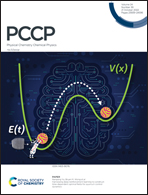Stretching-mode specificity in the Cl + CH3D(v1-I, v1-II, and v4 = 1; |jK〉) reactions: dependency on the initial |jK〉 selectivity†
Abstract
The title reactions were studied at a collisional energy of 5.4 kcal mol−1 in a crossed-beam product-imaging experiment. The dynamics attributes of the dominant ground-state CH2D(00) and the accompanied C–D bend-excited CH2D(61) products were imaged in reactions with totally 16 ro-vibrationally selected states of the CH3D(vi, |jK〉) reagents. We found that all three vibrational excitations yielded marked |jK〉-dependent rate-enhancements in forming the (00, 0/1)s product pairs. Furthermore, for a given rotational |jK〉-mode, a vibrational-mode propensity of v4 > v1-I > v1-II in rate promotion and a clear manifestation of the Fermi-phase-induced interference effect of the latter two were observed. Compared to the reactivity of the rotationless state |jK〉 = |00〉, a minute rotational-excitation of all three stretch-excited CH3D(vi = 1) reagents could yield significantly higher reaction rates for the product pair (00, 0)s, but not so for (00, 1)s. The signals in forming the (61, 0)s pair were clearly notable but smaller than that of the ground-state reaction product pair, (00, 0)g. An opposite propensity of v1-II ≈ v1-I > v4 with a milder dependency on the initial |jK〉-states was observed. The angular distributions of the (00, 0)s pairs were nearly identical for all ro-vibrationally excited reagents, displaying the typical trait for a direct abstraction of the rebound mechanism. Similar distributions were found for the (61, 0)s pairs; yet, both pairs deviated substantially from the peripheral feature of the ground-state reaction pair of (00, 0)g. Those of the (00, 1)s pairs in reactions with v4-excitation featured a prominent forward-peaking distribution—suggestive of a time-delayed, resonance-mediated pathway, again with little dependency on the initial |jK〉-states. As for the reactions with the two Fermi-dyads, v1-I and v1-II, albeit showing globally similar distributions to that for v4, a substantial variation with the initial rotational-mode excitation could be discerned in the forward-peaking features. To unravel the impact of the Fermi-phase on the |jK〉-dependent attributes, we adopted a comparative approach by contrasting the observations in reactions with the Fermi-dyad reagents (the superposition states) to those with the pure-state reagents. Remarkable distinctions are unveiled and elucidated with the unexplained results explicitly pointed out, which call for future theoretical investigations for deeper understanding.

- This article is part of the themed collection: 2022 PCCP HOT Articles


 Please wait while we load your content...
Please wait while we load your content...